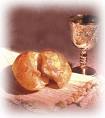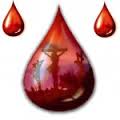| Next | Previous | Index | Tellout Home |
19. Holy Communion Elements
Bread Plus Wine
 When the Christian community gathers to celebrate the Lord's Supper, three essential elements must always be present for authenticity. "God" himself must be present in the person of the Holy Spirit. Matthew 18.20 assures us, "For where two or three gather in my name, there am I with them." The second of the Holy Communion elements necessary is that "Christians" must also be there as Christ's mystical body. Bread and wine must be there as the third Eucharistic element on the holy table. Substitute elements like grape juice or wafers, even gluten-free crackers, might be used in place of bread and wine. ✞
When the Christian community gathers to celebrate the Lord's Supper, three essential elements must always be present for authenticity. "God" himself must be present in the person of the Holy Spirit. Matthew 18.20 assures us, "For where two or three gather in my name, there am I with them." The second of the Holy Communion elements necessary is that "Christians" must also be there as Christ's mystical body. Bread and wine must be there as the third Eucharistic element on the holy table. Substitute elements like grape juice or wafers, even gluten-free crackers, might be used in place of bread and wine. ✞
Substitutes
During the Second World War in Japan, British prisoners of war substituted water and rice for wine and bread because nothing else was available. Saint Paul emphasized the "bread and wine's" symbolism as "Christ's body and blood" in 1 Corinthians 10.16-17, where he wrote, "Is not the of thanksgiving cup for which we give thanks, participation in Christ's blood? And is not the bread that we break a participation in the body of Christ? Because there is one loaf, we, who are many, are one body, for we all share the one loaf." ✞
A Warning
Saint Paul also warned in 1 Corinthians 10.21 that sexually immoral persons should not share in the Eucharist. He wrote, "You cannot drink the Lord's cup and the demons' cup too. You cannot have a part in both the Lord's table and the demons' table." Around the World, God's people who share in the one loaf are the second of the Holy Communion's unique elements. These are the believing Christian group meeting around the table bound and together by the head, Jesus Christ. God comes to the table in the Holy Spirit's form when Christians gather to celebrate and remember Jesus' death and resurrection. ✞
Celebration
 Various denominations use several different names for "Holy Communion" or "Communion." In Roman Catholic Churches, "Communion" is usually called "the Mass," a phrase derived from the Latin words of dismissal at the end of the service, "Ite, missa est," meaning something like, "Go, we send you away." For the celebration of the Eucharist in Eastern Christianity, including the Eastern Catholic Churches, other terms such as "Divine Liturgy, Holy Qurbana, and Badarak" are used instead. This sacrament is sometimes called "The Eucharist," which means "thanksgiving." "The Lord's Supper" or "The Lord's Table" are other alternatives and are reminders of the very first Holy Communion at the "Last Supper," which was the final meal Jesus held with his Apostles before his crucifixion. ✞
Various denominations use several different names for "Holy Communion" or "Communion." In Roman Catholic Churches, "Communion" is usually called "the Mass," a phrase derived from the Latin words of dismissal at the end of the service, "Ite, missa est," meaning something like, "Go, we send you away." For the celebration of the Eucharist in Eastern Christianity, including the Eastern Catholic Churches, other terms such as "Divine Liturgy, Holy Qurbana, and Badarak" are used instead. This sacrament is sometimes called "The Eucharist," which means "thanksgiving." "The Lord's Supper" or "The Lord's Table" are other alternatives and are reminders of the very first Holy Communion at the "Last Supper," which was the final meal Jesus held with his Apostles before his crucifixion. ✞
he Last Supper
All four Gospels describe the Last Supper. Matthew 26.26-30 reads, "While they were eating, Jesus took a loaf of bread, and after blessing it he broke it, gave it to the disciples, and said, 'Take, eat; this is my body.' Then he took a cup, and after giving thanks, he gave it to them, saying, 'Drink from it, all of you, for this is my blood of the covenant, which pours out for many for the forgiveness of sins. I tell you, I will never again drink of this fruit of the vine until that day when I drink it new with you in my Father's kingdom.' When they had sung the hymn, they went out to the Mount of Olives." ✞
Covenant Blood
The Greek phrase "my blood of the covenant" means equally "my blood of the new covenant." No matter where you live, every congregation must contain at least one committed Christian for the body of Christ to be present. The bread and wine are symbolic of Christian lives offered to God. The bread comes from wheat, water, yeast, salt, and the labor of many hands. The dough is worked and kneaded at the kitchen table and baked to perfection in a hot oven. Grapes are lovingly tended, harvested, pressed, and patiently fermented to be offered back to God as fine wine, the fruit of good soil, hard labor, and time. It is an occasion to be truly grateful as we remember Jesus' life on earth and his sacrificial death on a cross and his resurrection! ✞
Water Into Wine
 The word "blood" occurs 427 times in the Bible. Jesus' blood in the form of wine is a memorial of Jesus' death on the cross. Saint Augustine (354-430 AD) of Hippo in present-day Algeria wrote in his "Confessions," "We take for granted the slow miracles as year by year water irrigating a vineyard becomes wine. We stand amazed when the same process takes place in quick motion in Cana of Galilee." The miracle at Cana, where water was turned into wine by Jesus at a wedding, shows that Jesus has the power, like his Father, to create and recreate. Tiptoeing across the laws of nature, Jesus bends them for his glory and our greater understanding and benefit. ✞
The word "blood" occurs 427 times in the Bible. Jesus' blood in the form of wine is a memorial of Jesus' death on the cross. Saint Augustine (354-430 AD) of Hippo in present-day Algeria wrote in his "Confessions," "We take for granted the slow miracles as year by year water irrigating a vineyard becomes wine. We stand amazed when the same process takes place in quick motion in Cana of Galilee." The miracle at Cana, where water was turned into wine by Jesus at a wedding, shows that Jesus has the power, like his Father, to create and recreate. Tiptoeing across the laws of nature, Jesus bends them for his glory and our greater understanding and benefit. ✞
A New Covenant
The changing of water into wine at the Cana wedding points us to the wine presented at the Last Supper, which signifies his bloodshed at Calvary for our sins. Jesus does not play with his powers like a child in a sand pile. He uses his miracles to induce belief in his disciples, reinforcing their faith by what he does and says. Water, a transparent, clear fluid, is turned into the most delicious and aromatic wine. Jesus retakes the wine chalice at the institution of the Lord's Supper. Saint Paul records in 1 Corinthians 11.25, "In the same way after supper Jesus took the cup, saying, 'This cup is the new covenant in my blood, do this, whenever you drink it, in remembrance of me.'" ✞
Jesus' Sacrifice
 The mere thought of drinking "my blood," as is suggested by this verse, would have been repugnant to Jews because of its cannibalistic overtones. Leviticus 17.10-11 strictly prohibits Jews from any contact with blood, saying, "I will set my face against any Israelite or any foreigner residing among them who eats blood, and I will cut them off from the people. For the life of a creature is in the blood, and I have given it to you to make atonement for yourselves on the altar; it is the blood that makes atonement for one's life." The unique sacrificial nature of Jesus' death on the cross solves the puzzle of Jesus' blood. ✞
The mere thought of drinking "my blood," as is suggested by this verse, would have been repugnant to Jews because of its cannibalistic overtones. Leviticus 17.10-11 strictly prohibits Jews from any contact with blood, saying, "I will set my face against any Israelite or any foreigner residing among them who eats blood, and I will cut them off from the people. For the life of a creature is in the blood, and I have given it to you to make atonement for yourselves on the altar; it is the blood that makes atonement for one's life." The unique sacrificial nature of Jesus' death on the cross solves the puzzle of Jesus' blood. ✞
Meat Signed Off
In Leviticus 3.17, we also read, "You must not eat any fat or any blood." Jews, to this day, will eat no meat other than that specially prepared with the blood drained from it under the scrutiny and the signature of a Rabbi. I was once on a Trans-Atlantic flight and happened to be seated next to a strict Jewish person. He had the Orthodox "Jewish fedora," ringlets and a black suit. But when the meal came around, he discovered his dinner had been signed off by a Rabbi he didn't know and wouldn't accept it from the stewardess. He ended up with an apple from one of the cabin crew's lunch! I felt sorry for him, but his tradition had bound him up. ✞
Jesus Salvation Chalice
 The wine vessel or the "cup of Jesus" or the 'Holy Grail,' emphasizes the fundamental importance of the Holy Communion celebration. In medieval legend, this was the cup or shallow dish used by Jesus at the Last Supper and in which Joseph of Arimathea received Christ's blood at the cross. The Arthurian Legends, written from the early 13th century onward, described quests for it by medieval knights. ✞
The wine vessel or the "cup of Jesus" or the 'Holy Grail,' emphasizes the fundamental importance of the Holy Communion celebration. In medieval legend, this was the cup or shallow dish used by Jesus at the Last Supper and in which Joseph of Arimathea received Christ's blood at the cross. The Arthurian Legends, written from the early 13th century onward, described quests for it by medieval knights. ✞
Old Testament Blood
Blood was significant in the Old Testament. At the Exodus from Egypt, each household's lamb's blood marked the doorposts of Israelite houses. As a result, God's death spirit passed over the home and saved the firstborn child from death. The blood on the doorpost was considered by Early Church Christians as a symbol of Christ's sacrifice for sin upon the cross so that God's righteous anger might not fall on members of His Mystical Body. Jesus' blood brought about protection for Mystical Body members from the penalty of sins committed. Jesus' salvation cup at Holy Communion bears the same tell-tale marks of the cross of Christ. Saint Peter tells us in 1 Peter 1.18-19 that we are redeemed "with the precious blood of Christ, a Lamb without blemish or defect." All humans have blood tainted by sin. We are all born in sin, and we must, therefore, all die. Jesus is the only one who can stand in our place at the final judgment because he is sinless. His blood is pure and untainted. ✞
"Holy Communion Elements"
by Ron Meacock © 2021
| ^Top Page | Next | Previous |